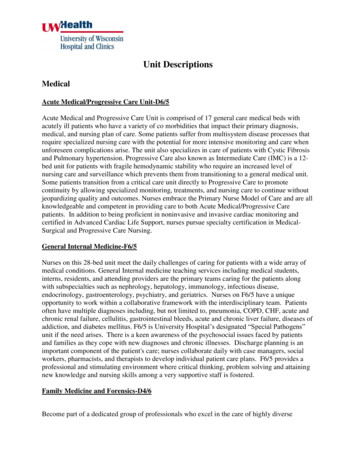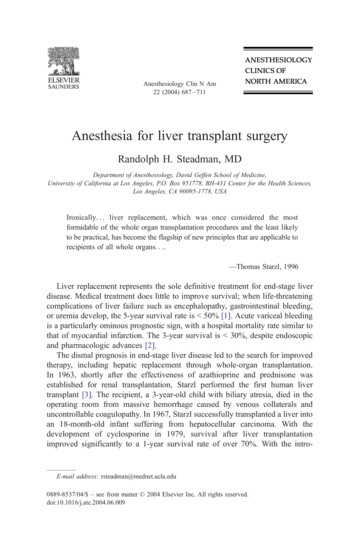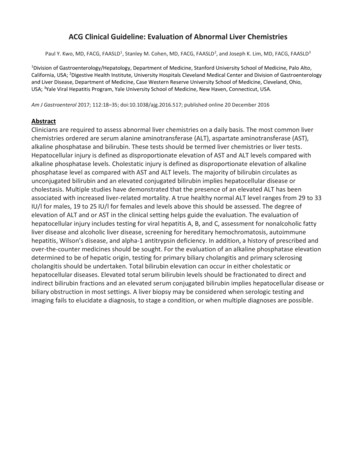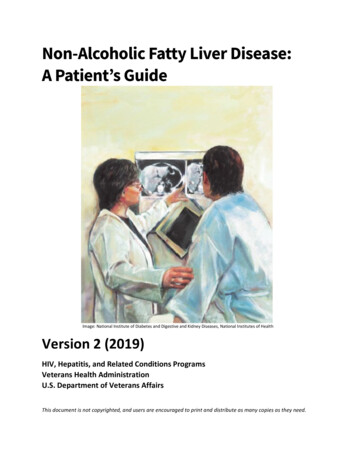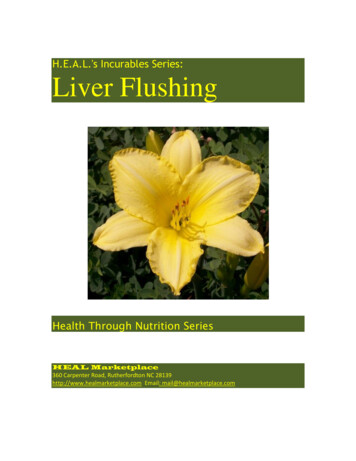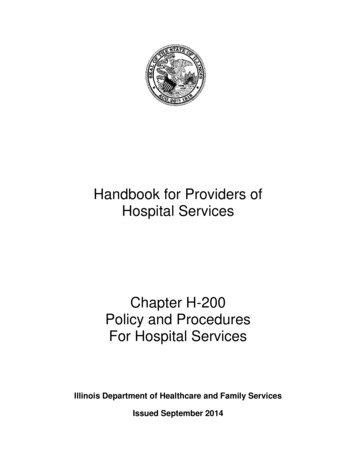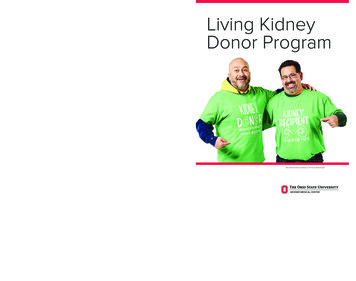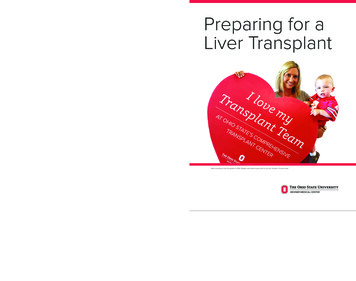
Transcription
Preparing for aLiver TransplantLiver transplant recipient education video:http://go.osu.edu/LiverTrxEducationVideo for hearing impaired with closed reparing for aLiver TransplantOhio State Comprehensive Transplant CenterAbdominal Transplant Clinic300 W. 10th Ave., 11th FloorColumbus, OH fter receiving a liver transplant in 2001, Morgan was able to give birth to her son, Graham, 13 years later.TXLVR 202748903
WelcomeThe Ohio State University Wexner Medical Center Comprehensive Transplant Centerdoctors and staff welcome you as a possible liver transplant candidate.Our Comprehensive Transplant Center has one of the largest organ transplant programsin the nation and is a preferred provider for all major insurance companies. We perform600 liver, kidney, pancreas, heart and lung transplants each year. Since our programbegan in 1967, we’ve performed 11,000 lifesaving transplants, including over 1,300 livertransplants.As you begin this journey, you and your family may have many questions and concerns.We hope this information helps you to learn about the process of liver transplantation soyou know what to expect.The goal of a liver transplant is to allow you to live a more normal life. But there arechanges you’ll need to make after transplantation to have the best outcome.For More InformationIt’s common to feel both concerned and excited as you consider a liver transplant.Please call to talk with a pre-transplant coordinator to get more information and addressyour questions and concerns.Phone: 614-293-6724 or 800-293-8965Monday through Friday8 a.m. to 4 p.m.After regular hours, a phone tree will direct you to the right person to leave a message.Ohio State Hepatology Clinic410 W. 10th Ave.2nd floor, Doan HallColumbus, OH 43210Phone: 614-293-6255Fax: 614-293-8518April, liver recipient (transplantedJanuary 2017), pictured withher husband, Aaron, and two sons,Oliver (held) and Samuel (standing)
William, liver recipient (transplanted July 2015) pictured with his wife, Teresa1 - ABOUT THE LIVERAbout the Liver
About the LiverThe liver is the largest internal organ and weighs about 2 to 4pounds. It lies in the right side of the upper abdomen, next tothe stomach. The rib cage covers most of the liver, except thearea just below the breast bone. Under the liver is the stomach,large intestine, the right kidney and the gallbladder.A healthy liver does many things to keep your body workingwell, such as: Helps your body fight infection by destroying germs inyour blood Removes or changes almost every hormone, drug andchemical that enters or is already present in your body Makes and stores substances that help clot blood, called clotting factors Stores glucose, vitamins and minerals like iron and releases them when your body needs them Produces bile to help digest foodBlood is supplied to the liver by two large blood vessels. The hepatic artery supplies blood that’s rich withoxygen to the liver. The portal vein brings blood from the stomach, small intestine, spleen and pancreas tothe liver to supply it with nutrients.
Liver Disease and CirrhosisThere are many diseases that can damage your liver, causing cirrhosis. Your liver doctor, called ahepatologist, can help you understand your liver disease.Liver disease causes scarring in the liver, called cirrhosis. The scar tissue blocks the flow of blood throughthe liver. This blockage causes the liver to be slow in breaking down food products, hormones, medicineand waste products in the body. It also slows the liver’s ability to make proteins and other substances.Causes of Cirrhosis: Alcoholism Chronic hepatitis (type B and C are more common) Non-alcoholic fatty liver disease (NAFLD), which is related to insulin resistance and diabetes Inherited diseases, such as Wilson’s disease and alpha-1 antitrypsin (AAT) deficiency Autoimmune disorders, such as primary biliary cirrhosis (PBC) and primary sclerosing cholangitis (PSC) Autoimmune hepatitis Heart failure with liver involvement Hemochromatosis Reactions to prescribed medicines and exposure to environmental toxins are less common causesMelissa, liver recipient(transplanted March 2012),pictured with her husband, Jeff3
Signs of Cirrhosis:Damage to the liver can’t be repaired, but treatment can slow or stop more damage. Problems or signsthat are often seen include: Feeling tired or weak Loss of appetite, nausea and weight loss Kidney damage Portal hypertension — high blood pressure in the portal vein system that carries blood from thedigestive organs to the liver Pruritus — itchy skin Jaundice — yellowing of your skin caused by too much bilirubin in your blood Ascites — swelling in the abdomen due to a buildup of fluid. If your protein is low in your bloodvessels, fluid can leak into your belly to cause ascites. Hepatic encephalopathy (HE) — changes in alertness, confusion, forgetfulness, problemsconcentrating or increased sleepiness. Increased amounts of ammonia in your body can cause thesechanges in thinking. If you have HE, avoid use of opioid or narcotic pain medicines, sleeping pills andanti-anxiety medicines. Varices — swollen blood vessels in the stomach or esophagus. May have black tarry stools or vomitblood if these vessels bleed. Sometimes the bleeding is severe and can be life-threatening.Infections in the abdomen, damage to the gallbladder and kidneys can also occur, along with manyother problems.4Lauren, liver transplant recipient (green shirt – transplanted December 2016) pictured with her mom, Susan, dad, Rick and boyfriend, Nathan
Liver TransplantProcess2 - TRANSPLANT PROCESSMelvin, liver recipient (transplanted September 2018)
Liver Transplant ProcessWe strongly encourage you to have a support person attend all your office visits, testing appointments andeducation sessions with you. Because of your liver disease, you may have problems remembering andthinking, so your support person can be a second set of eyes and ears to help you.Transplant Process StepsThe journey through the process of organ transplant requires several steps.1. Referral for Transplant2. Transplant Education3. Testing4. Evaluation Day5. Patient Selection Committee (PSC) Review6. Transplant Wait List7. Getting the CallWe will review each of these steps to help you know what you can expect. Please ask any questions youmay have and let us know if there is anything that you don’t understand.
Step 1: Referral for TransplantYour doctor may have talked to you about having a liver transplant because of the amount of damage youhave to your liver.HepatologistIf you want to consider a transplant, you will need to be seen by a hepatologist, a doctor who treats liverdisease patients. This doctor will review your records and may do other testing to determine the amount ofdamage you have to your liver and if transplantation may be a good treatment option for you.If you are a candidate for transplant, your hepatologist will refer you to The Ohio State University WexnerMedical Center Comprehensive Transplant Center for more information and testing, plus continue to workwith the transplant team. Your hepatologist will manage your liver disease treatment and medicines, whetheror not you become a transplant candidate.Transplant TeamOnce you have been referred to the Ohio State Wexner Medical Center’s transplant center, you will be seenby many members of the transplant team to help you understand the process and what to expect. Some ofthe team includes: Transplant surgeon — doctor involved in reviewing your history and doing an exam. This doctor or anothertransplant surgeon may do the transplant surgery. Pre-transplant coordinator — registered nurse (RN) who will work with you through the process fromyour referral until transplant surgery. You will need to let this coordinator know about any hospital stays,changes in your health or any changes in your contact information. After surgery, you will have a posttransplant coordinator, who is also a nurse. Transplant financial coordinator — works with you to help you understand the costs of transplantation andany benefits you may be eligible for. Transplant social worker — will work with you to check that you have support and coping skills to deal withthe transplant process. If you have a history of problems with drug or alcohol use, the social worker willalso assist you with meeting transplant guidelines and may refer you to a psychologist if needed. Transplant psychologist — doctor who will work with you, if needed, to be sure you have the support andcoping skills to handle the stress of the transplant process or coordinate alcohol and/or drug counseling. Transplant dietitian — will work with you to review your eating habits and diet and help you makeadjustments to manage your health.7
Step 2: Transplant EducationIf you’re considering a liver transplant, the next step in the process is to attend an education session. Asa transplant candidate, you’re expected to attend this class with your support person to learn about thetransplant process. Your support person can be a family member or friend who will support you throughthe process and help with your recovery after surgery.Our abdominal transplant office will contact you to schedule your education session. After attending theclass, you’ll be given further instructions on how to proceed, if you choose to continue.You cannot enter the education session late. If you arrive late, you’ll need to call the transplant office toreschedule. Please plan to be seated about 15 minutes before the session starts.Step 3: TestingYou will be scheduled to have tests done to check your current health and whether you’re able to havetransplant surgery. These tests may be scheduled at the Ohio State Wexner Medical Center or you may beable to have some of the testing done at your primary care doctor’s office or a local lab.Tests may include: Abdominal imaging by ultrasound, CT or MRI Blood tests Electrocardiogram (EKG or ECG) to check your heartbeat patterns Echocardiogram to check the pressure in your heart and lungs and to check blood flow through your heart Pulmonary function testing to check how well your lungs are working Arterial blood gas (ABG) to check oxygen levels in your blood Six-minute walk test (stress test) to check your heart and lungs when you are active Chest X-ray Cancer screening that may include:- Colonoscopy if older than 50- Mammogram for women over 40 (within one year)- PSA for men- Pap smear for women (within one year)8
Step 4: Evaluation DayOnce education is completed, you’ll be scheduled for an evaluation day. You’re also expected to bring atleast one support person with you to this appointment.You should expect to meet with members of the transplant team, such as: Pre-transplant coordinator — will meet to review your medical history Hepatologist or surgeon — will talk with you about the plan for the liver transplant and review the results ofyour tests. You’ll have a physical exam, and the risks and benefits of the surgery will be reviewed with you. Dietitian — will review your current diet and nutrition status to create a plan to keep you healthy. Changesto cooking and food prep and use of nutrition supplements may be discussed. Financial coordinator — will talk about your health insurance benefits and other financial resources,including your income and savings. This person will help you to create a financial plan to cover the cost ofthe transplant and follow-up care, as needed.You may also need to be seen by other doctors. These appointments may not happen on the same day asthe rest of your evaluation. Cardiologist (heart specialist) — will review the results of some of your tests to determine if you have anyheart issues Infectious disease doctor — will review your vaccination history and recommend vaccines that may beneeded before transplantBased on the findings from your evaluation, you may need additional tests or you may be given otherguidelines that you need to meet before you are able to proceed to the committee review.Once your evaluation is complete, your case will be presented to the liver transplant Patient SelectionCommittee (PSC).Alcohol and Drug Use:Alcohol and illegal drug use can cause more liver damage. If you drink alcohol or use drugs, you will be sent for counseling and three months of treatment to helpyou meet requirements for transplant listing. If you are on the liver transplant waiting list and you test positive for alcohol or illegal drugs, you may beplaced on inactive status or you may be removed from the waiting list. Random drug and alcohol screening is done for all liver transplant patients. If you are called to have adrug or alcohol screening, you have 24 hours to complete the needed test or it will be assumed thatyour results are positive and actions will be taken.9
Step 5: Patient SelectionCommittee (PSC) ReviewWhen your testing and evaluations are completed, you’ll be presented as a liver transplant candidate at thePatient Selection Committee (PSC) meeting. This is a multidisciplinary team of physicians and non-physicians,some of whom you’ve met during your evaluation process. The committee has the responsibility of thoroughlyreviewing each patient’s case and determining not only if you’re an acceptable candidate for transplant, butalso if there’s any other intervention possible before proceeding with transplant.All aspects of your evaluation will be discussed, and a decision will be made about your candidacy. There arethree possible results:1. You’re approved for the transplant wait list.2. No decision is made about your candidacy, and you may be asked to complete additional testing.3. You’re not approved for the transplant wait list. This may be a permanent or temporary decision. Continueyour care with your liver specialist doctor. You may be referred back for transplant evaluation in the future.Your hepatologist or the pre-transplant coordinator will contact you to let you know the decision from the PSCabout your case.If you are an acceptable candidate, the transplant center will work to get your insurance approval for thesurgery. They will also contact the OSOTC (Ohio Solid Organ Transplantation Consortium) to get approval tohave you added to the liver transplant wait list.Step 6: Transplant Wait ListYou’ll receive a letter and a phone call when you’ve been placed on the liver transplant list. There are severalfactors that determine your rank or placement on the wait list: Blood type Weight range MELD-Na scoreBlood TypeThere are four blood groups on the list: A, AB, B and O. O and A are the most common blood types and have a longer wait list, but they also have moredonors available. AB and B groups have shorter lists, but there are fewer donors in these groups.10
Weight RangeThe donor liver size can determine the recipient. Each patient on the wait list will have a weight range basedon their body size.MELD-Na ScoreThe Model for End-Stage Liver Disease (MELD) and sodium (Na) score is a useful tool for both you andyour health care team as you plan for a transplant. It is a numbered scale that estimates how well your liveris working. The sodium level is an indicator of how serious your liver disease may be. With cirrhosis, thefunction of the liver can change constantly, even every day. These changes are seen in your blood work,which is used to find your MELD-Na score.The scores range from 6, which means the liver is working well, to 40, which means the liver is workingpoorly and the person needs an urgent transplant.The number is calculated by a formula using four routine lab test results:1. Bilirubin: Measures how well your liver gets rid of bile, a fluid produced in the liver that helps withabsorption and digestion.2. INR: Measures your liver’s ability to make blood clotting factors.3. Creatinine: Measures kidney function. Kidney function is often affected by liver disease.4. Sodium (Na): Measures the fluid balance in your body.These labs are drawn at certain times based on your current MELD-Na.You should have three tubes of blood drawn for this testing. These tests are required for you to remain onthe active wait list. If you miss a scheduled test, you will be placed on hold and you will not be eligible for atransplant until the tests are complete.If you want to enter your lab values to know your MELD-Na score, you can use a calculator at this -calculators/meld-calculator.Sue, liver transplant recipient(transplanted February 1991)11
While Waiting Make sure that you’re available by phone, check your messages and respond right away. You needto return the call within one hour to determine if you are well enough to transplant. If you don’t return thephone call in that time, the coordinator will contact the next person on the transplant list and you will missthe opportunity. Be sure to stay in close contact with your transplant coordinator. Let the coordinator know right away ifyou have:- Changes in your health, especially if you are seen in a hospital outside of the Ohio State WexnerMedical Center- Changes to any of your medicines- Changes to your contact information or your family contact information if you listed them as a contactfor you- Plans to leave the state on vacation or for other reasons. You may be placed on hold if you are outof range- Any changes to your support system- Any changes in your insurance You should have plans ready for child and pet care, if needed, as well as transportation arranged, so youare ready if you get a call. You are expected to abstain from using drugs or alcohol while you are on the transplant list. You maybe required to get random drug screenings done while you are on the transplant list. You will need to have ongoing lab work. You also need to have yearly dental exams, heart testing or other imaging tests, and you must update yourpsychosocial form each year. Be sure to keep all of your appointments with your primary care doctor and liver specialist and have yourneeded lab work completed.MELD-Na Lab WorkBased on your current MELD-Na score, you will need to have lab work done to keep you active on the waitlist. If your lab work is not done as required, you will go on hold, and you will not be eligible to receive atransplant until the tests are completed.You should always have at least three tubes of blood drawn for MELD-Na labs. You may have monthly tissuetyping labs drawn in addition to the MELD-Na tubes if you need a liver and kidney transplant.Frequency of MELD-Na Lab TestsHow often you need to be tested is based on your MELD-Na score. If your current MELD-Na is: 25 or higher, you need testing every seven days 19 to 24, you need testing every month 11 to 18, you need testing every three months 10 or less, you need testing every 12 months12
Wait List HoldYou may be placed on a wait list hold for many reasons. You can’t receive organ offers while on hold, but youare still on the list. Some of the reasons to be placed on hold include: You’re too sick to be safe for transplant surgery. You aren’t current with your lab work or other testing and appointments. You had a positive drug screen. Your doctor or the Patient Selection Committee has placed you on hold because you aren’t following throughwith required care.If you’re removed from the transplant wait list, you’ll receive a phone call and a letter of notification.Contact the Transplant TeamYour transplant coordinator is available if you have any questions or concerns. All calls are routed to thecoordinators and prioritized based on urgency. Calls are most often returned the same day they’re received.If you have an emergency, do not drive yourself to the emergency room. Ask the doctor in the emergencyroom to call the Ohio State Hepatology Clinic at 614-293-6255. If after hours, leave a message, and someonewill call back.Step 7: Getting the CallCall from CoordinatorA transplant coordinator will call you when a potential organ is available. Coordinators from different groupsmake calls to patients to offer organs, so you may not be talking to your assigned liver pre-transplantcoordinator. Organ offers come at all hours of the day and night. Be sure to keep your phone on at night. The phone number that the coordinator is calling from will not always show as an Ohio State number onyour caller ID. Please do not screen calls, as you may miss the call for an organ offer. You have one hour from the time the coordinator first called you to return the call. You do not have to beat the hospital in an hour, but you do need to return the call. The coordinator will keep trying to call you and anyone listed as a contact for you during the hour. When the coordinator reaches you, you’ll need to provide information about any changes to your medicalhistory, infections, fevers and the distance you are away from the hospital. You may be asked to come to the hospital and then be sent home if the organ does not appear to be a goodmatch for you or if the organ is of poor quality. This would not change your position on the wait list. You mayalso be sent home if you have an infection, test positive for drugs or alcohol, or have a new health problemthat would make surgery unsafe for you.13
Be sure to bring these items with you to the hospital:- Photo ID- Insurance card(s)- Current list of all medicines- Power of attorney or living will documents- Medical history and list of past surgeries- List of important phone numbers- Personal hygiene items Do not bring jewelry, large amounts of money or other valuables with you to the hospital. For the safety of all patients on the transplant unit, children age 12 or younger are not permitted to visit. Inaddition, live plants, fresh fruits and vegetables, and fresh flowers are not permitted on the transplant unit.Increased Risk Organ OffersYou may be offered an organ that is considered to be an increased risk, determined by test results or behaviorof the donor. The transplant team would only offer an organ that they feel would benefit you. The reason theorgan is increased risk will not be shared with you when you get the call. If you agree to accept the organ,you will receive more information from the surgeon when you arrive at the hospital and will sign an additionalconsent to receive the organ. It’s important to note that the surgical team would not accept the organ unlessthey believe the benefits of transplant outweigh the risks.For example: Hepatitis B core positive organs may be offered if you have chronic hepatitis B or have been vaccinatedagainst hepatitis B, because the risk of getting the hepatitis B virus would be very small. Patients with or without active hepatitis C may also be offered hepatitis C positive organs, as the benefitsof transplant outweigh the risks from the hepatitis C organ. After the transplant, the patient would also betreated for hepatitis C.Other types of organs you may be offered include: Liver from a donor who dies after cardiac arrest. The doctor would discuss differences with this organ. This isnot an increased risk organ and does not require an additional consent. Part of a donated liver, called a split liver, may be offered to certain patients who qualify for this type oftransplant. This is not an increased risk organ and does not require an additional consent.14
Liver TransplantSurgery3 - TRANSPLANT SURGERYDouglas, liver recipient (transplanted February 2017)
Transplant SurgeryAfter you receive the call from your transplant coordinator, you’ll be admitted to the Transplant Unit on the10th floor of Rhodes Hall at The Ohio State University Wexner Medical Center.Upon arrival, you’ll have multiple lab tests done to ensure you are ready for transplant. You will be given anumber of medications, including antibiotics, antifungals and immunosuppression medications.Possible Risks or Problems from SurgeryThe doctor will talk with you about risks and benefits of transplant surgery before you sign the surgeryconsent form. There may be other risks, based on the donor organ and other factors. Ask questions if youdon’t understand the risks as the doctor explains them to you. The major risks include: Bleeding Infection Pneumonia Heart complications Blood clots DeathSurgery Can Take Four to Six HoursIdeally, surgery is performed as soon as the organ is available. However, using the latest perfusiontechniques, we are able to transplant livers within 12 to 24 hours after organ recovery. When you are taken tothe operating room, you’ll have general anesthesia, so you won’t be awake through the surgery. The doctorswill cut an upside-down Y, called a chevron incision, on your abdomen. The transplanted liver will be placedthrough this incision. If you still have your gallbladder, it will be removed to reduce possible problems aftersurgery.You’ll have a breathing tube and several IV lines in place after the surgery is done. You’ll also have severaldrains to drain fluid out to allow healing. The incision will be closed with staples. You will likely be on oxygenand a heart monitor. You’ll also have wraps on your legs that are connected to a pump, called a sequentialcompression device or SCD, to prevent blood clots from forming in your legs while in the hospital.Chevron Incision for Liver Transplant
Care After Surgery4 - CARE AFTER SURGERYKrista, liver recipient (center – transplanted February 2017), pictured with her daughter, Shelbi, and husband, Ken
Care After SurgeryMost transplant patients will spend a few days in the Surgical Intensive Care Unit (SICU). When you are able tobreathe on your own, the breathing tube will be removed and you’ll be moved to the transplant unit to continue yourrecovery.Most liver transplant patients will be in the hospital about 11 days. The unit staff will teach you and your supportperson about your care with an organ transplant, such as: Your immunosuppression medicines to prevent rejection of the transplant How to prevent infections How to care for your surgical incision Problems that you should watch for and who to call
Immunosuppression Medicines (Also Called Anti-Rejection Medicines)Your immune system helps protect your body from infection and fights off things that might be harmful to you.After your organ transplant, your immune system will know the transplanted liver isn’t part of your original body.Because of this, it may try to fight against the liver transplant and reject it or rid your body of the transplanted organ.Immunosuppression medicines (also called anti-rejection medicines) must be taken after transplant surgery to reduceyour body’s chances of rejecting your newly transplanted liver. You will need to take these medicines two to threetimes each day, every day, for the rest of your life. As a transplant patient, you need to learn about your medicinesand how to take them, including what side effects to watch for.You will also need to have lab work done often to check the levels of your medicines to be sure they’re in theright range to work best for you. You should never stop taking these medicines, or change the dose, without firstchecking with your transplant doctor. Doses will change, and you need to communicate closely with your post-transplant coordinator to be sure youunderstand your instructions. Only an Ohio State Wexner Medical Center transplant doctor should be making changes to your transplantmedicines.Protect Yourself from InfectionsBecause immunosuppression medicines weaken your body’s immune system, you need to take extra steps to stayhealthy. You’ll be taught about how to protect yourself, such as: Good hand washing Avoiding others who are sick19
Working with Your Post-Transplant CoordinatorYou’ll get a call from a post-transplant coordinator 24 to 48 hours after you leave the hospital after your transplantsurgery. The coordinator is your contact for any questions you may have about your care. The coordinator will alsowork with you to coordinate lab work and management of your medicines.Appointments After Transplant You should plan to have appointments for follow-up every week for the first month. Lab work will be done two times every week for the first three months. Based on your condition, you may see the doctor very frequently right after your transplant. Be sure to keep all ofyour appointments.Can I Contact the Donor Family?This is your decision. Every donor family and situation is different. Some donor families want to share about theirloved one, while others find it too difficult.Please call Lifeline of Ohio at 800-525-5667 to find out more about contacting your donor family.20
Brian, liver-kidney recipient (transplanted December 2018), pictured with his wife and kids5 - OTHER TREATMENT OPTIONSOther TreatmentOptions
What if Transplant Isn’tRight for Me?There is no cure for cirrhosis, other than liver transplant. If transplant is not for you for whatever reason, thereare other treatments that may benefit you. Some of these treatments may be used to manage your conditionwhile you wait for a transplant.Here is some information about possible treatment options. Talk to your liver doctor about treatments tomanage your disease.Treatment Options TIPS (Transjugular Intrahepatic Portosystemic Shunt) — during this procedure, a small metal tube calleda shunt or stent is placed in the liver to connect two blood vessels. This is done to improve blood flowthrough the liver, reducing the pressure in the liver, to limit further damage. Heat Ablation or Radio Frequency Ablation — during this procedure, a small probe is inserted through theskin and into the liver. The probe produces heat to burn small growths, called tumors, in order to slow orstop further growth. Chemoembolization — during this procedure, chemotherapy drugs are give
education sessions with you. Because of your liver disease, you may have problems remembering and thinking, so your support person can be a second set of eyes and ears to help you. Transplant Process Steps The journey through the process of organ transplant requires several steps. 1. Referral for Transplant 2. Transplant Education 3. Testing 4 .
